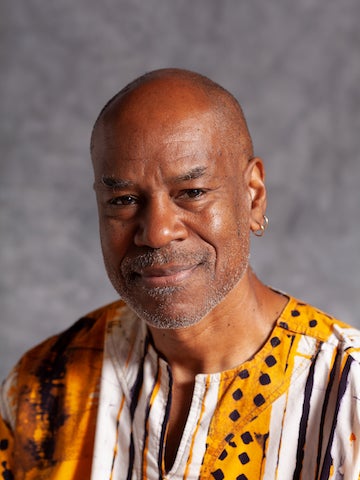The Story Behind the Gesture
Oberlin professor and studio artist Johnny Coleman shares why he feels compelled to recognize Lorain, Ohio, native and Nobel Laureate Toni Morrison at Oberlin, and why he’s inviting others to join In Celebration of Toni Morrison: A Gesture of Love and Reflection.
As an artist, an astute cultural critic, and revered Elder from the very same landscape in which my children were born and raised, Toni Morrison‘s work continues to have a deep and personal impact upon me.
The impact of Ms. Morrison’s life and the breadth of her work qualitatively enriched a generation of writers whose work has come to be read, how the work is read, and to whom the writers are speaking. The manner within which her work speaks to the interior lives of everyday black people resonates with readers the world over. She is a global citizen who left this world enriched by her presence here.

Photo credit: John Seyfried
Morrison grew up in Lorain, about 11 miles north from Oberlin and she has spoken at Oberlin College on several occasions. There is a connection here. She also initiated, along with the Toni Morrison Society, a Bench by the Road project . The engraved bench and accompanying marker are in a landscaped area on the corner of North Main and Lorain Streets, near Wurtzel Theater. Morrison wanted to honor the memory of enslaved people who sought refuge in select cities along what was called the Underground Railroad. Oberlin is part of that historic and secretive path to freedom. Oberlin’s bench was installed in 2012.
In a speech she gave when she accepted the Melcher Book Award for her novel, Beloved, she said, ‘There is no place you or I can go, to think about or not think about, to summon the presences of, or recollect the absences of slaves; nothing that reminds us of the ones who made the journey and of those who did(not) make it. There is no suitable memorial or plaque or wreath or wall or park or skyscraper lobby. There’s no 300-foot tower. There’s no small bench by the road. ...’
I first read Tar Baby in the late ‘80s, followed by Beloved. From the very beginning, I was struck by the visual clarity and richness of her language on the page. I continued reading her work, Sula, Song of Solomon, and read Beloved again for the second time when my daughter was born. I have read and reread that narrative many times.
The Gesture Described
What was the impetus for doing this program?
I was driving alone on the morning of Tuesday, August, 6, when I heard that Ms. Toni Morrison had passed the previous day. A week or so later, I woke up very early and could not go back to sleep. The outline of the gesture began forming in my thoughts.
Given the significance of Ms. Morrison’s impact, in recognition of the day on which she was born, I feel that it is important that we come together; across region, generation, culture, and nation to celebrate her as one village.
What is meant by ‘gesture?‘
I am referencing a coordinated effort. One in which individuals spanning this Earth, across our differences of culture, place, and circumstance, converge as a community not limited by geography to reflect upon the deeply resonant work of Toni Morrison.
It’s an intentionally composed moment spanning the duration of this day, within which a creative act intersects with a transformative event; a catalytic process.
Why would people outside of Oberlin take interest and or want to participate?
The body of her work speaks so directly, with such truthfulness, to the complexity of the human experience. This gesture is for a global audience—those for whom Toni Morrison’s work is resonant and those for whom her work will become a resonant and guiding ight in the future.
My hope is that this event will function as a dynamic and deeply resonant celebration of the seminal life and work of Toni Morrison.
Of Love and Reflection
Coleman sat down with Oberlin colleague, A.G. Miller, retired professor of religion, to discuss how he felt a calling, an obligation to honor a fellow artist whose literary work struck his artistic sensibilities and created a lifelong connection.
Contact the Team
- To share your reflections, refer to the Recording Guidelines.
- For questions about the event, send email to Johnny.Coleman@oberlin.edu .
- For technical assistance, send email to Kyle.Hartzell@oberlin.edu .
- For questions about the release form, send email to Office of Donor Relations , or call 440-775-6785.
What to Expect
People from all over the world will be invited to call in to Oberlin’s Irene and Alen Wurtzel Theater, to read a favorite passage of her writing or share a memory.
The event will take place from 9 a.m. to 6 p.m., February 18; Morrison’s birthdate.
These streaming voices will be woven as softly spoken invocations, reminiscent of voices at the church altar on any Sunday, Coleman explains. The passages will emerge from within small West African architectural structures laid out in an arc before a streaming image of the Bench by the Road, which is near Wurtzel Theater.
Simultaneously, a procession of individuals will read their own favorite selections live at the site. The full expanse of the event will be filmed and streamed back to viewers in real time. In this way, Coleman hopes to create an extended moment during which individuals might pause and come together in a singular ‘‘gesture of acknowledgement’’ not limited by geography.